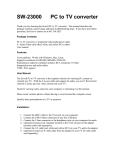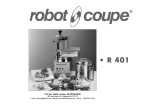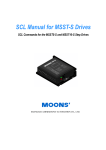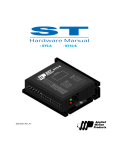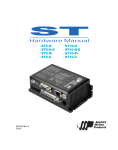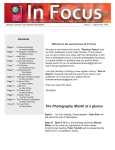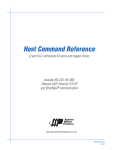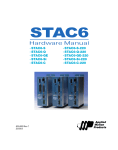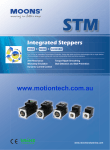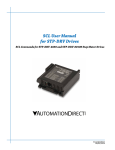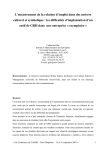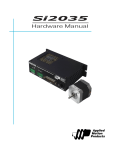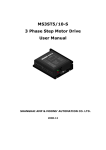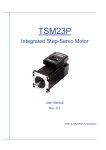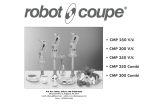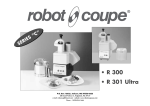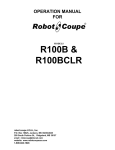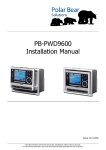Download STM17S - MOONS
Transcript
STM17S Integrated Motor User Manual Rev. 1.0 AMP & MOONS’ Automation STM17S User Manual Contents 1 Introduction............................................................................4 1.1 Features........................................................................................4 1.2 Block Diagram..............................................................................5 1.3 Safety Instructions........................................................................6 2 Getting Started.......................................................................7 2.1 Installing Software........................................................................7 2.2 Mounting Hardware......................................................................7 2.3 Choosing a Power Supply............................................................8 2.3.1 Voltage Selection............................................................................. 8 2.3.2 Current........................................................................................... 10 3 Installation/Connections.................................................... 14 3.1 Connecting the Power Supply.....................................................14 3.2 Connecting the STM17S Communications..................................15 3.2.1 Connecting to a PC using RS-232................................................. 15 3.2.2 Connecting to a host using RS-422/485......................................... 16 3.2.3 Assigning Addresses...................................................................... 19 3.3 Inputs and Outputs.......................................................................20 3.3.1 3.3.2 3.3.3 3.3.4 3.3.5 Connector Pin Diagram.................................................................. 20 STEP & DIR Digital Inputs.............................................................. 21 EN Digital Input.............................................................................. 22 AIN Input......................................................................................... 23 Programmable Output.................................................................... 23 4 Configuration........................................................................25 4.1 Configurator Menus.....................................................................25 4.1.1 File Menu........................................................................................ 25 4.1.2 Drive Menu..................................................................................... 25 4.1.3 Help Menu...................................................................................... 26 4.2 Drive/Revision..............................................................................26 4.3 Motor (Integrated Motor)..............................................................27 4.3.1 4.3.2 4.3.3 4.3.4 4.3.5 4.3.6 4.3.7 Running Current............................................................................. 27 Accel/Decel Current........................................................................ 27 Idle Current..................................................................................... 27 Idle Current Delay.......................................................................... 28 Load Inertia.................................................................................... 28 Electronic Damping/Anti-Resonance.............................................. 28 Waveform Smoothing..................................................................... 28 4.4 Motion & I/O.................................................................................29 4.4.1 Pulse & Direction Mode.................................................................. 29 4.4.2 Velocity Mode................................................................................. 32 4.4.3 SCL Mode (Serial Command Language)....................................... 34 Rev. 1.1 8/25/2010 2 STM17S User Manual 4.5 Encoder (optional).......................................................................36 4.6 Uploading /Downloading..............................................................37 5 Simple Operation..................................................................38 6 Troubleshooting...................................................................40 LED Error Codes................................................................................40 7 Reference Materials.............................................................. 41 7.1 7.2 7.3 7.4 7.5 Mechanical Outlines....................................................................41 Technical Specifications...............................................................42 Torque Speed Curves .................................................................44 SCL Command Reference ..........................................................45 Drive/Motor Heating.....................................................................47 8 Contacting MOONS’............................................................. 50 The information in this manual applies to the following products: Model STM17S-1AN Communications RS-232 STM17S-1RN STM17S-1AE STM17S-1RE STM17S-2AN STM17S-2RE STM17S-3AN STM17S-3RN STM17S-3AE STM17S-2RN STM17S-2AE RS-485 Optional Encoder STM17S-3RE 3 Rev. 1.1 8/25/2010 STM17S User Manual 1 Introduction Thank you for selecting the MOONS’ STM17S Integrated Motor. The STM17 Series Integrated Step Motors incorporate DSP driver technology and integrate the drive electronics with the motor. This provides smooth, precise motion along with ease of set-up and configuration, all at a low cost. We hope our commitment to performance, quality and economy will result in a successful motion control project. 1.1 Features • Programmable, micro-stepping digital step motor and driver in an integrated package • Operates from a 12 to 48 volt DC power supply • Control Modes: Pulse Input • • • Velocity Step and Direction CW/CCW A/B Quadrature (Encoder following) • • • Position Analog Velocity Switch Control Velocity Serial Commanded Velocity • Analog Position • Serial Commanded Position • Communications: RS-232 RS-422/485 • Optional encoder feedback • Available torque: STM17S-1 up to 0.23 N.m STM17S-2 up to 0.38 N.m STM17S-3 up to 0.48 N.m • I/O: Digital Input filtering both hardware and software 3 optically isolated digital inputs, 5 to 24 volts 1 optically isolated digital output, 30V 100mA 1 analog input for speed and position control, 0 to 5 volts • Technological advances: Step input signal smoothing Mid-band anti-resonance Rev. 1.1 8/25/2010 4 STM17S User Manual 1.2 Block Diagram (30V, 80mA) 5 Rev. 1.1 8/25/2010 STM17S User Manual 1.3 Safety Instructions Only qualified personnel should transport, assemble, install, operate, or maintain this equipment. Properly qualified personnel are persons who are familiar with the transport, assembly, installation, operation, and maintenance of motors, and who meet the appropriate qualifications for their jobs. To minimize the risk of potential safety problems, all applicable local and national codes regulating the installation and operation of equipment should be followed. These codes may vary from area to area and it is the responsibility of the operating personnel to determine which codes should be followed, and to verify that the equipment, installation, and operation are in compliance with the latest revision of these codes. Equipment damage or serious injury to personnel can result from the failure to follow all applicable codes and standards. MOONS’ does not guarantee the products described in this publication are suitable for a particular application, nor do they assume any responsibility for product design, installation, or operation. • Read all available documentation before assembly and operation. Incorrect handling of the products referenced in this manual can result in injury and damage to persons and machinery. All technical information concerning the installation requirements must be strictly adhered to. • It is vital to ensure that all system components are connected to earth ground. Electrical safety is impossible without a low-resistance earth connection. • This product contains electrostatically sensitive components that can be damaged by incorrect handling. Follow qualified anti-static procedures before touching the product. • During operation keep all covers and cabinet doors shut to avoid any hazards that could possibly cause severe damage to the product or personal health. • During operation the product may have components that are live or have hot surfaces. • Never plug in or unplug the Integrated Motor while the system is live. The possibility of electric arcing can cause damage. Be alert to the potential for personal injury. Follow recommended precautions and safe operating practices emphasized with alert symbols. Safety notices in this manual provide important information. Read and be familiar with these instructions before attempting installation, operation, or maintenance. The purpose of this section is to alert users to the possible safety hazards associated with this equipment and the precautions necessary to reduce the risk of personal injury and damage to equipment. Failure to observe these precautions could result in serious bodily injury, damage to the equipment, or operational difficulty. Rev. 1.1 8/25/2010 6 STM17S User Manual 2 Getting Started The following items are needed: • a 12 - 48 volt DC power supply, see the section below entitled “Choosing a Power Supply” for help in choosing the right one • a small flat blade screwdriver for tightening the connectors (included) • a PC running Microsoft Windows 98, 2000, NT, Me, XP, Vista, or Windows 7 • the MOONS’ CD (included) • a MOONS’ programming cable (included with RS-232 Models; RS-422/485 converters are available from MOONS’) 2.1 Installing Software Before utilizing the STM17S Integrated Motor and ST Configurator Software in an application, the following steps are necessary: • Install the ST Configurator software from the CD. • Connect the drive to the PC using the programming cable. When using RS-422/485, it must be set up in a 4-Wire configuration (see “Connecting to a host using RS-422/485” below.) • Connect the drive to the power supply. See instructions below. • Launch the software by clicking Start...Programs...MOONS’. • Apply power to the drive. • The software will recognize the drive and display the model and firmware version. At this point, it is ready for use. 2.2 Mounting Hardware As with any step motor, the STM17S must be mounted so as to provide maximum heat sinking and airflow. Keep enough space around the Integrated Motor to allow for airflow. • Never use the drive where there is no airflow or where other devices cause the surrounding air to be more than 40°C (104°F). • Never put the drive where it can get wet. • Never use the drive where metal or other electrically conductive particles can infiltrate the drive. • Always provide airflow around the drive. 7 Rev. 1.1 8/25/2010 STM17S User Manual 2.3 Choosing a Power Supply The main considerations when choosing a power supply are the voltage and current requirements for the application. 2.3.1 Voltage Selection The STM17S is designed to give optimum performance between 12 and 48 Volts DC. Choosing the voltage depends on the performance needed and motor/drive heating that is acceptable and/or does not cause a drive over-temperature. Higher voltages will give higher speed performance but will cause the STM17S to produce higher temperatures. Using power supplies with voltage outputs that are near the drive maximum may significantly reduce the operational duty-cycle. The extended range of operation can be as low as 10 VDC minimum to as high as 55 VDC maximum. When operating below 12 VDC, the power supply input may require larger capacitance to prevent under-voltage and internal-supply alarms. Current spikes may make supply readings erratic. The supply input cannot go below 12 VDC for reliable operation. Absolute minimum power supply input is 10 VDC. If the Input supply drops below 10 VDC the low voltage alarm will be triggered. This will not fault the drive. Absolute maximum power supply input is 55 VDC at which point an over-voltage alarm and fault will occur. When using a power supply that is regulated and is near the drive maximum voltage of 55 VDC, a voltage clamp may be required to prevent over-voltage when regeneration occurs. The RC050 Regeneration Clamp is recommended for the STM17S in this situation (see 3.1 Connecting the Power Supply below). When using an unregulated power supply, make sure the no-load voltage of the supply does not exceed the drive’s maximum input voltage of 55 VDC. The charts below show the heat output, in watts, of the drive at various speeds and voltages. See section 7.5 on Drive/Motor Heating for more information. STM17S-1AN Wattage vs Speed 1.8 Amps @ Ambient of 40°C 80 x 80x 6(mm) Aluminum Plate 60 12V Watts 24V Watts 48V Watts 50 Watts 40 30 20 10 0 0 Rev. 1.1 8/25/2010 10 20 30 Speed(RPS) 8 40 50 STM17S User Manual STM17S-2AN Wattage vs Speed 1.8 Amps @ Ambient of 40°C 80 x 80x 6(mm) Aluminum Plate 60 12V Watts 24V Watts 48V Watts 50 Watts 40 30 20 10 0 0 10 20 30 Speed(RPS) 40 STM17S-3AN Wattage vs Speed 1.8 Amps @ Ambient of 40°C 80 x 80x 6(mm) Aluminum Plate 60 50 12V Watts 24V Watts 48V Watts 50 Watts 40 30 20 10 0 0 10 20 30 Speed(RPS) 9 40 50 Rev. 1.1 8/25/2010 STM17S User Manual 2.3.2 Current The maximum supply currents required by the STM17S are shown in the charts below at different power supply voltage inputs. The STM17S power supply current is lower than the winding currents because it uses switching amplifiers to convert a high voltage and low current into lower voltage and higher current. The more the power supply voltage exceeds the motor voltage, the less current will be required from the power supply. It is important to note that the current draw is significantly different at higher speeds depending on the torque load to the motor. Estimating how much current is necessary may require a good analysis of the load the motor will encounter. STM17S-1AN Supply Current @ 12V/1.8Amps 40 1.2 1 30 0.8 25 20 0.6 15 0.4 10 0.2 5 0 Torque Supply Current(A) Torque(Oz.In) 35 Supply Current (Full Load) Supply Current (No Load) 0 0 10 20 30 40 50 Speed(RPS) STM17S-1AN Supply Current @ 24V/1.8Amps 1.2 Torque(Oz.In) 35 1 30 0.8 25 20 0.6 15 0.4 10 0.2 5 0 0 0 10 20 30 40 Speed(RPS) Rev. 1.1 8/25/2010 10 50 Torque Supply Current(A) 40 Supply Current (Full Load) Supply Current (No Load) STM17S User Manual STM17S-1AN Supply Current @ 48V/1.8Amps Torque(Oz.In) 35 1 30 0.8 25 0.6 20 15 0.4 10 0.2 5 0 Supply Current(A) 1.2 40 Torque Supply Current (Full Load) Supply Current (No Load) 0 0 10 20 30 40 50 Speed(RPS) 60 1.2 50 1 40 0.8 30 0.6 20 0.4 10 0.2 0 Torque Supply Current(A) Torque(Oz.In) STM17S-2AN Supply Current @ 12V/1.8Amps Supply Current (Full Load) Supply Current (No Load) 0 0 5 10 15 20 25 30 35 40 Speed(RPS) STM17S-2AN Supply Current @ 24V/1.8Amps 60 Torque(Oz.In) 50 0.8 40 0.6 30 0.4 20 0.2 10 0 Supply Current(A) 1 Torque Supply Current (Full Load) Supply Current (No Load) 0 0 10 20 30 40 50 Speed(RPS) 11 Rev. 1.1 8/25/2010 STM17S User Manual 1 0.9 0.8 0.7 0.6 0.5 0.4 0.3 0.2 0.1 0 60 Torque(Oz.In) 50 40 30 20 10 0 0 10 20 30 40 Supply Current(A) STM17S-2AN Supply Current @ 48V/1.8Amps Torque Supply Current (Full Load) Supply Current (No Load) 50 Speed(RPS) STM17S-3AN Supply Current @ 12V/1.8Amps 80 Torque(Oz.In) 70 1 60 0.8 50 40 0.6 30 0.4 20 0.2 10 0 Supply Current(A) 1.2 Torque Supply Current (Full Load) Supply Current (No Load) 0 0 10 20 30 40 50 Speed(RPS) STM17S-3AN Supply Current @ 24V/1.8Amps 80 Torque(Oz.In) 70 1 60 0.8 50 40 0.6 30 0.4 20 0.2 10 0 0 0 10 20 30 40 Speed(RPS) Rev. 1.1 8/25/2010 12 50 Supply Current(A) 1.2 Torque Supply Current (Full Load) Supply Current (No Load) STM17S User Manual STM17S-3AN Supply Current @ 48V/1.8Amps 1.2 Torque(Oz.In) 70 1 60 0.8 50 0.6 40 30 0.4 20 0.2 10 0 Torque Supply Current(A) 80 Supply Current (Full Load) Supply Current (No Load) 0 0 10 20 30 40 50 Speed(RPS) 13 Rev. 1.1 8/25/2010 STM17S User Manual 3 Installation/Connections 3.1 Connecting the Power Supply Connect the power supply “+” terminal to the drive “+” terminal and the power supply “-” terminal to the drive “-” terminal using 16 to 20-gauge wire. The STM17S contains an internal fuse connected to the “+” terminal. This fuse is not user replaceable. If a user serviceable fuse is desired, install a 2 amp fast acting fuse in line with the “+” power supply lead. To Power SupplyTo Power Supply+ To Earth Ground Be careful not to reverse the wires. Reversing the connection may open the internal fuse and void the warranty. If a regulated power supply is being used, there may be a problem with regeneration. When a load decelerates rapidly from a high speed, some of the kinetic energy of the load is transferred back to the power supply, possibly tripping the over-voltage protection of a regulated power supply, causing it to shut down. This problem can be solved with the use of a MOONS’ RC050 Regeneration Clamp. It is recommended that an RC050 initially be installed in an application. If the “regen” LED on the RC050 never flashes, the clamp is not necessary. LEDs Green - power Red - regen RC050 Regen Clamp Rev. 1.1 8/25/2010 14 STM17S User Manual 3.2 Connecting the STM17S Communications The STM17S is available with two types of serial communications, RS-232 (STM17S-xAx) or RS422/485 (STM17S-xRx). Each type requires a different hardware connection for interface to a PC or other Host system. The RS-232 version comes with a cable that will provide the interface to an RS-232 port through a DB9 style connector. The RS-422/485 version requires the user to provide both the cabling and the RS-422/485 interface. Below are descriptions of how to interface both of these serial communication types to a PC. 3.2.1 Connecting to a PC using RS-232 Locate the STM17S within 2.5 meters of the PC. Plug the large end (DB9 connector) of the communication cable that came with the drive into the serial port of the PC. The small end will have a 5-pin spring clamp connector. Plug this end into the appropriate connector on the STM17S. Secure the cable to the PC with the screws on the DB9 connector. NOTE: If the PC does not have an RS-232 serial port, a USB Serial Converter will be needed. Recommended USB to DB9 Serial adapters are: • Item #26886 from CablesToGo (http://www.CablesToGo.com) • SW1301 from Sewel (http://www.SewellDirect.com) • HL-340 from Alibaba (http://detail.china.alibaba.com/buyer /offerdetail/587993633.html) For laptops, the SSP-100 PCMCIA converter card from http://www.SewellDirect.com is recommended. Ground (circuit ground) Ground (circuit ground) TX (Transmit) +5V (Internal Jumper Select) RX (Receive) RS-232 Connector diagram The RS-232 circuitry does not have any extra electrical “hardening” and care should be taken when connecting to the RS-232 port as hot plugging could result in circuit failure. If this is a concern the RS-422/485 version should be used. 15 Rev. 1.1 8/25/2010 STM17S User Manual 3.2.2 Connecting to a host using RS-422/485 RS-422/485 communication allows connection of more than one drive to a single host PC, PLC, HMI or other computer. It also allows the communication cable to be long (more than 300 meters or 1000 feet). The use of Category 5 cable is recommended as it is widely used for computer networks, inexpensive, easily obtained and certified for quality and data integrity. The STM17S can be used with either Two-Wire or Four-Wire RS-422/485 implementation. The connection can be point-to-point (i.e. one drive and one host) or a multi-drop network (one host and up to 32 drives). NOTE: To use the STM17S RS-422/485 version with the ST Configurator software, it must be connected in the Four-Wire configuration (see below) Rx+ RxTx+ TxGND RS-422/485 Connector diagram Four-Wire Configuration Four-Wire Systems utilize separate transmit and receive wires. One pair of wires must connect the host’s transmit signals to each drive’s RX+ and RX- terminals. The other pair connects the drive’s TX+ and TX- terminals to the host’s receive signals. A logic ground terminal is provided on each drive and can be used to keep all drives at the same ground potential. This terminal connects internally to the DC power supply return (V-), so if all the drives on the RS-422/485 network are powered from the same supply it is not necessary to connect the logic grounds. One drive’s GND terminal should still be connected to the host computer ground. Because the host in a four-wire system never needs to disable its transmitter, software is simplified. Some converters make this process very difficult to implement and can delay communications. to PC GND to PC RXto PC RX+ to PC TXto PC TX+ GND TXTX+ RX- GND TXTX+ RX- GND TXTX+ RX- RX+ RX+ RX+ Drive#1 Drive#2 120 Drive#3 RS-422/485: 4-wire system diagram NOTE: If the PC does not have an RS-422/485 serial port, a converter will be required. Rev. 1.1 8/25/2010 16 STM17S User Manual RS-232 to RS-422/485 4-wire Converter: ■■ 22-25AL (25-pin) from Integrity Instruments (http://www.rs-485.com). Connect as follows: Adaptor T+ TR+ RSHLD Drive RX+ RXTX+ TXGND Requires a 7.5 to 24 Volt power supply USB to RS-422/485 4-wire Converter ■■ IR-1401B from Beijing itRob Intelligent Telecommunication Co. (http://www.itrob.cn/2_ Products/2_Products_IR-1401B.htm). Adaptor T+ TR+ RGND Drive RX+ RXTX+ TXGND The +5V of the converter is not used Two-Wire Configuration In a 2-wire system, the host must disable its transmitter before it can receive data. This must be done quickly before a drive begins to answer a query. The STM17S includes a transmit delay parameter that can be adjusted to compensate for a host that is slow to disable its transmitter. This adjustment can be made over the network using the Transmit Delay (TD) command, or it can be set using the ST Configurator software. It is not necessary to set the transmit delay in a four wire system. to PC GND to PC TX-(A) to PC TX+(B) GND GND TX- TX- TX+ TX+ RXRX+ RXRX+ Drive#1 Drive#2 GND TX120 TX+ RXRX+ Drive#3 RS-422/485: 2-wire system diagram NOTE: If the PC does not have an RS-422/485 serial port, a converter will be required. 17 Rev. 1.1 8/25/2010 STM17S User Manual RS-232 to RS-422/485 2-wire Converter: ■■ 485-25EL (25-pin) or 485-9E (9-pin) from Integrity Instruments (http://www.rs-485.com). Connect the adaptor’s “B” pin to the STM17S’s TX+ and RX+ terminals. Connect the “A” pin to the drive’s TX- and RX- terminals. Connect as follows: Adaptor B A B A SHLD Drive RX+ RXTX+ TXGND Requires a 7.5 to 24 Volt power supply USB to RS-422/485 2-wire Converters ■■ USB-COMi-M from byterunner technologies (http://www.byterunner.com). Set SW1 to ON and SW2-4 to OFF. Connect pin 1 of the converter to RX- and TX-. Connect pin 2 to RX+ and TX+. Pin 6 is ground. The DB-9 is not used. Connect as follows: Adaptor PIN2 PIN1 PIN2 PIN1 PIN6 Drive RX+ RXTX+ TXGND ■■ IR-1401B from Beijing itRob Intelligent Telecommunication Co. (http://www.itrob.cn/2_Products/2_Products_IR-1401B.htm). Connect D+ of the converter to RX+ and TX+ of the drive. Connect D- of the converter to RX- and TX- of the drive. Connect GND of the converter to GND of the drive. The +5V, R+ and R- connections of the converter are not used. The converter will automatically operate in 2-wire mode. Connect as follows: Adaptor D+ DD+ DGND Drive RX+ RXTX+ TXGND The +5V of the converter is not used Rev. 1.1 8/25/2010 18 STM17S User Manual 3.2.3 Assigning Addresses Before the entire system is wired, each drive will need to connect individually to the host computer so that it can be assigned a unique address. Once the drive has been connected to the PC as described above, launch the ST Configurator software. Apply power to the drive. If a drive has already been configured, click the Upload button so that the ST Configurator settings match those of the drive. Click on the Motion button and select the SCL operating mode. The numerals 0..9 or the special characters ! “ # $ % & ‘ ( ) * + , - . / : ; < = > ? @ may be used as addresses. Make sure each drive on the network has a unique address. On a 2-wire network, the Transmit Delay may also need to be set. Most adapters work well with 10 milliseconds. Once the address has been assigned, click Download to save the settings to the drive. 19 Rev. 1.1 8/25/2010 STM17S User Manual 3.3 Inputs and Outputs The STM17S has three types of inputs: • High speed digital inputs for step & direction commands or encoder following, 5 to 24 volt logic • Low speed digital input for other signals, 5 to 24 volt logic • Analog input for analog speed and positioning modes All drives include 3 digital inputs and 1 analog input • STEP & DIR are high-speed digital inputs for commanding position. Quadrature signals from encoders can also be used. When not being used for the Step & Direction function these inputs can be used for CW & CCW Limit, CW & CCW Jogging and Run/Stop & Direction Velocity modes. • EN is a low speed software programmable input and can be used for Motor Enable and/or Alarm Reset. This input can also be connected to a sensor, switch or other device for use with Wait Input (WI), Seek Home (SH), Feed to Sensor (FS), On Input (OI) and other commands. • AIN is an analog input for a velocity or position command signal. It can accept 0-5 volts and has gain, filtering, offset and dead-band settings. 3.3.1 Connector Pin Diagram inside drive STEP+ STEPDIR+ DIREN+ ENOUT+ RES OUT+5V AIN GND Rev. 1.1 8/25/2010 20 100mA Limit Signal Conditioning STM17S User Manual 3.3.2 STEP & DIR Digital Inputs The diagrams below show how to connect the STEP & DIR Inputs to various commonly used devices. DIR+ +5v to +24v out Indexer with Sinking Outputs DIR STM17 5 – 24V High Speed Inputs DIRSTEP+ STEP STEP- Connecting to Indexer with Sinking Outputs Indexer with Sourcing Outputs DIR DIR+ COM DIR- STEP STEP+ STEP- STM17 5 – 24V High Speed Inputs Connecting to Indexer with Sourcing Outputs Indexer with Differential Outputs DIR+ DIR+ DIR- DIR- STEP+ STEP+ STEP- STEP- STM17 5 – 24V High Speed Inputs Connecting to Indexer with Differential Outputs Many high-speed indexers have differential outputs A+ STEP+ A- STEP- B+ DIR+ B- DIR- GND GND Master Encoder STM17 Wiring for Encoder Following + 5 to 24V Power Supply DIR+ direction switch DIR- run/stop switch (closed=run) - STM17 STEP+ STEP- Using Mechanical Switches 21 Rev. 1.1 8/25/2010 STM17S User Manual 3.3.3 EN Digital Input While the STEP and DIR inputs are designed for high-speed digital input operation, the Enable (EN) input is designed for low speed digital input operation between 5 and 24 volts. Note: If current is flowing into or out of an input, the logic state of that input is low or closed. If no current is flowing, or the input is not connected, the logic state is high or open. The diagrams below show how to connect the EN input to various commonly used devices. 5 to 24 volt Power Supply + EN+ STM17 Switch or Relay (closed = logic low) - EN- Connecting the Input to a Switch or Relay 5 to 24 volt Power Supply + - EN+ + NPN Proximity Sensor − STM17 output EN- Connecting an NPN type Proximity Sensor to an input (when prox sensor activates, input goes low) 5 to 24 volt Power Supply + + PNP Proximity Sensor - - output EN+ STM17 EN- Connecting an PNP type Proximity Sensor to an input (when prox sensor activates, input goes low) Rev. 1.1 8/25/2010 22 STM17S User Manual 3.3.4 AIN Input The STM17S drives have an analog input (AIN) which can accept a signal range of 0 to 5 volts. The drive can be configured to operate at a speed or position that is proportional to the analog signal. Use the ST Configurator software to set the signal range, offset, dead-band and filter frequency. The STM17S provides a +5VDC 100mA limit voltage supply that can be used to power external devices such as potentiometers. It is not the most accurate supply for reference, for more precise readings use an external supply that can provide the desired accuracy. I/O Connector inside drive +5v AIN +5v OUT 100 mA limit 1-10k Ω pot Signal Conditioning CW AIN CCW STM17 GND GND Connecting a Potentiometer to the Analog Input 3.3.5 Programmable Output The STM17S drives feature one optically isolated digital output (OUT). This output can be set to automatically control a motor brake, to signal a fault condition, to indicate when the motor is moving or to provide an output frequency proportional to motor speed (tach signal). Or the output can be turned on and off by program instructions like Set Output (SO). The output can be used to drive LEDs, relays and the inputs of other electronic devices like PLCs and counters. The OUT+ (collector) and OUT- (emitter) terminals of the transistor are available at the connector. This allows the output to be configured for current sourcing or sinking. Diagrams of various connection types follow. Do not connect the output to more than 30 volts. The current through the output terminal must not exceed 100mA. 5 – 24 volt Power Supply + STM17 OUT+ - Load OUT- Connecting a Sinking Output 23 Rev. 1.1 8/25/2010 STM17S User Manual 5 – 24 volt Power Supply + - OUT+ COM OUT- IN PLC STM17 Connecting a Sourcing Output 5 – 24 volt Power Supply + STM17 - OUT+ COM PLC OUT- IN Connecting a Sourcing Output again 5 – 24 volt Power Supply relay + OUT+ STM17 OUT- 1N4935 suppression diode Driving a Relay Rev. 1.1 8/25/2010 24 - STM17S User Manual 4 Configuration ST Configurator is the PC based software application that is used to configure the STM17S, check status and perform basic operations. ST Configurator can also upload, save, or open any saved STM17S configurations. Motor configuration for the STM17S is rather simple as most parameters are fixed. Because this is an integrated motor/driver, the configuration generally has only two elements - the Motion & I/O and the Motor. The optional encoder adds a third element. 4.1 Configurator Menus 4.1.1 File Menu In the File Menu previously created configurations can be Opened and new or altered configurations can be Saved. Any setup can be Printed. The Exit command will close the ST Configurator. 4.1.2 Drive Menu The Drive menu provides access to several features. • Alarm History will display the last eight alarms and/or faults. • If an alarm or fault condition is being displayed, Clear Alarm will clear it. • Restore Factory Defaults will return the drive to its original factory configuration. • SCL Terminal allows SCL commands to be entered to test the drive’s response, creating an opportunity for commands to be learned before host control software is written (see section 5 on Simple Operation below). 25 Rev. 1.1 8/25/2010 STM17S User Manual • Self Test rotates the motor a half revolution in alternating directions at a low speed to allow verification that the motor is connected and functioning properly (see section 5 on Simple Operation below). • Status Monitor displays real time drive status including: • State (open or closed) of all inputs • State of output (click the HI/LO buttons to force an output) • Motor speed • Voltage at the analog input • Alarms or faults • Status flags (enabled, motion, jogging, etc.) The motor can be enabled or disabled from the Status Monitor by clicking the buttons at the bottom of the display. 4.1.3 Help Menu The Help Menu allows access to the help screens via Contents, gives Contact information for MOONS’, links the user to the Website, and gives technical information About ST Configurator. 4.2 Drive/Revision Normally the drive model and revision are automatically detected when the STM17S is powered up while the ST Configurator software is active and the STM17S is connected to the PC serial port. If the box does not list the correct model after the STM17S is powered up, please check the wired connections (including the power supply and communications connections.) If the STM17S is intentionally not connected, the model and revision can be chosen from the drop down list on the upper right. This will provide the correct screen options and offline configuration can be accomplished and saved in a file on the PC. Rev. 1.1 8/25/2010 26 STM17S User Manual 4.3 Motor (Integrated Motor) In the Integrated Motor dialog box, operational parameters are defined and configured. Motor Specs cannot be modified as they are fixed according to the STM17S model selected in the Drive selection box. 4.3.1 Running Current This value is set by default to a current level that gives good performance at constant speed but lower than the maximum current to allow the integrated motor to operate at a lower temperature. If the application requires full torque at full speed, this value can be increased up to the Rated Current of the integrated motor. If an application is particularly heat sensitive and there is more torque available than needed, motor heating may be reduced by lowering the running current. 4.3.2 Accel/Decel Current This value is set by default to the Rated Current of the integrated motor so that maximum torque is provided during the acceleration or deceleration phase of a move profile. The purpose of the Accel/Decel Current is to allow the integrated motor to operate at a lower current and therefore cooler when at a constant speed while still having full torque when needed especially if the load is high inertia. This value can be reduced for lower torque and operating temperature. 4.3.3 Idle Current Idle Current is set as a percentage of the Running Current with a maximum setting of 90%. The Idle Current reduces motor heating by lowering the current when the motor is at rest. In most cases, the default value of 50% works well. Motor heating may be further reduced by lowering the Idle Current percentage even more. 27 Rev. 1.1 8/25/2010 STM17S User Manual 4.3.4 Idle Current Delay The Idle Current Delay is the amount of time between when the motor stops and the current is reduced to the Idle Current value. It is recommended to allow a little time for the motor to settle out before the current is reduced. Note: All current values represent the peak value of the sine wave. 4.3.5 Load Inertia This anti-resonance feature is most effective if the load inertia is set precisely. If this is a known value, the first option circle should be clicked, the inertia entered, and units of measurement selected. If the exact inertia is not known, the second option circle should be selected and an approximate load to motor inertia ratio entered. This number can be adjusted as needed. 4.3.6 Electronic Damping/Anti-Resonance The checkbox allows this feature to be enabled or disabled. By default the feature is enabled as this is recommended. There may be a rare case where disabling the feature is desired. 4.3.7 Waveform Smoothing By default this is disabled. Consult factory for details when enabling this feature. Rev. 1.1 8/25/2010 28 STM17S User Manual 4.4 Motion & I/O Clicking on the Motion button will bring up the Motion menu where one of several operating modes may be selected. Pulse & Direction Mode, Velocity (Oscillator) Mode, and Serial Command Language (SCL) are the modes available for the S drives. (Multiaxis MisNet Hub is not available on the STM17S.) 4.4.1 Pulse & Direction Mode This mode is for systems where the position of the motor is determined by a digital input signal in the form of pulses. There are three Digital Signal Types available: Digital Signal Type Pulse and Direction A signal such as that generated by a step motor controller is used. In this mode, the frequency of the pulses fed into one input determines the speed of the motor. The direction of rotation is determined by a signal fed into another input. Either an ON or OFF signal can be configured to represent clockwise motion. 29 Rev. 1.1 8/25/2010 STM17S User Manual CW and CCW Pulse The drive has two inputs allocated to this feature and the motor will move CW or CCW depending on which input the pulse is fed into. A & B Quadrature This is sometimes called “Slave Mode.” Signals fed to the drive from a master encoder control the movement of the motor. The encoder may be mounted on a shaft on the machine or can be another motor in the system. For all Digital Signal Type modes a value will need to be entered in the Steps/Rev, Step Smoothing Filter and Input Noise Filter fields. Steps/Rev Steps/Rev allows adjustment of the way the drive responds to incoming step pulses. If a step motor drive in an existing application is being replaced with a new drive, the new drive can be configured here to have the same number of steps/rev as the old one. In a new application, this value should be entered in accordance with the pulse source or indexer. The motor will provide smoother, more precise motion with a higher step count, but when the frequency of the indexer is limited, the steps/rev may need to be reduced to achieve the desired speed range. For example, in an application requiring a maximum speed of 20 revs/second where the indexer is limited to a 100kHz maximum pulse rate, the steps/rev should be no higher than 5000. A particular value may also be entered to make one step result in a convenient increment of motion. For example, in a linear motion application using a lead screw with a pitch of 5 turns per inch, 20,000 steps/rev will provide a nominal movement of .00001 inches per step. Move lengths can be more easily calculated with this method. For a metric application with the same lead screw, 50,800 steps/rev would result in .0001 mm per step. Encoder following applications can also be easily configured with a particular Steps/Rev value. To drive the motor two turns for every one turn of a 2000 count/rev (500 line) encoder, the value of 1000 steps/rev would be entered. Step Smoothing Filter When in Pulse & Direction Mode, the step input command can be filtered so that if low Step/ Rev counts such as 200 or 400 are being used, the actual motor movement is smoother. The smoothing filter can effectively cause the motor to operate as if the Step/Rev count is 20000. The filter range is 10 to 2000Hz; the smaller the filter value, the smoother the stepping. As with most types of filters lower filter frequencies will cause a step lag in the move profile with the amount of lag dependant on the filter value, the Step/Rev count value, and the speed of the move. See the table below for a general idea of the lag that will be present with given filter frequency values. If the lag due to the filter causes undesirable results, a higher step rate and filter frequency may be required. Setting the frequency to its maximum of 2000 effectively turns off the filter. Rev. 1.1 8/25/2010 30 STM17S User Manual Step Lag vs. Speed (Steps/Rev=2000) Step Count lag 1400 1200 SF=1000 1000 SF=500 800 SF=250 SF=100 600 SF=50 400 SF=25 200 0 0 10 20 30 rev/sec 40 50 NOTE: SF = Step Smoothing filter value in Hz Input Noise Filter The digital inputs used for the Pulse & Direction Mode are very high speed and can be sensitive to external electrical noise. The Input Noise Filter sets a hardware circuit to filter out unwanted noise that can cause extra steps. As a general rule, set the filter frequency to double that of the desired maximum input frequency. Setting the frequency too low may cause loss of step counts. When setting this value take care to analyze the performance over the whole range of desired speeds. Other I/O Settings Functions can also be assigned to the EN Input and the Output in the Pulse & Direction Control box. Options for the EN Input are: • Enable motor when closed - the motor is enabled when there is no current flowing through the input and it has no power when the input is open • Enable motor when open - the motor is enabled when there is current flowing through the input and it has no power when the input is closed • Reset alarm when closing - an alarm or fault can be cleared by closing the input • Reset alarm when opening - an alarm or fault can be cleared by opening the input • Not used - there is no function for the input, but its state can be read using the SCL Immediate Inputs (IS), Feed to Sensor (FS) or Feed to Sensor with Safety Distance (FY) command. Options for Output are: • Closed on fault - the output will close if a fault occurs • Open on fault - the output will open if a fault occurs • Closed to release brake - the output controls a fail safe brake relay • Open to release brake - the output opens to release the brake • Closed when moving - the output closes whenever the motor is moving • Open when moving - the output opens whenever the motor is moving • Tach out - the output produces pulses relative to the motor position • Not used - there is no function for the output, but it can be controlled using the SCL Set Output 31 Rev. 1.1 8/25/2010 STM17S User Manual (SO), Feed to Length and Set Output (FO), Immediate High Output (IH), and Immediate Low Output (IL) commands. 4.4.2 Velocity Mode In Velocity Mode the motor’s speed is controlled by analog and/or digital inputs. The drive is setup and all available I/O are configured in the Velocity Dialog box. • Checking the Use STEP input as Run/Stop will command the drive to run using a switch or signal from another electronic device. If this box is not checked, the motor will run at all times unless the Speed proportional to analog input box is checked and the analog input voltage is set at 0. • The DIR input is always active and will set the direction of any motion.The motor running parameters can be set to affect the fixed Speed (revs/sec), Acceleration (revs/s/s) and Deceleration (revs/s/s) rates. • When it is desired for the drive to run in analog input mode, the Speed proportional to analog input box must be checked. The maximum speed corresponding to 5V analog input is set in the Analog Input box. When the value 10 rev/sec at +5V is set, 2.5V analog input will produce 5 rev/sec. The analog input can also change the motor direction if an Offset value is entered under the Advanced Settings tab. Rev. 1.1 8/25/2010 32 STM17S User Manual Advanced Analog Settings • Offset: When a joystick will be used to operate the drive in both directions, an Offset must be entered that is half the voltage range of the joystick. If the drive’s 5V output is being used to power an analog joystick, the offset could be set to 2.5V for equal speed in both directions. The maximum speed is half the value entered in the Analog Input box above and so 2.5V analog input will correspond to zero speed. Auto Offset can be used to effectively “zero” the analog input value. This is very useful when the analog input value cannot be measured externally. • Deadband: When it is necessary to stop the motor with an analog signal that doesn’t go to 0 volts or an offset value, (potentiometers can usually go to 0 volts, but electronic circuits usually can’t), a deadband is required. This is the range of voltages in which the motor does not run and is useful for stopping the motor when the joystick is released. • Filter Frequency: If the analog signal is noisy, the motor speed may not remain constant. Industrial systems often pick up electrical noise on an analog wire and the STM17’S highresolution 12-bit analog input may respond to the noise. If this occurs, the analog filter frequency should be lowered until the issue is resolved. If the frequency is set too low, the motor may change speed more slowly than specified in the acceleration and deceleration boxes due to excessive filtering. Other I/O Settings Options for the EN Input are: • Change motor speed - when the input is closed, the motor will run at a different speed which must be entered in the Change motor speed to box • Enable motor when closed - the motor is enabled when current is flowing through the input and has no power when the input is open • Reset alarm when closing - an alarm or fault can be cleared by closing the input • Reset alarm when opening - an alarm or fault can be cleared by opening the input • Not used - there is no function for the input, but its state can be read using the SCL Immediate Inputs (IS), Feed to Sensor (FS) or Feed to Sensor with Safety Distance (FY) command. Options for Output are: • Closed on fault - the output will close if a fault occurs • Open on fault - the output will open if a fault occurs • Closed to release brake - the output controls a fail safe brake relay 33 Rev. 1.1 8/25/2010 STM17S User Manual • Open to release brake - the output opens to release the brake • Closed when moving - the output closes whenever the motor is moving • Open when moving - the output opens whenever the motor is moving • Tach out - the output produces pulses relative to the motor position • Not used - there is no function for the output, but it can be controlled using the SCL Set Output (SO), Feed to Length and Set Output (FO), Immediate High Output (IH), and Immediate Low Output (IL) commands. 4.4.3 SCL Mode (Serial Command Language) Here the power up mode for the drive is set for use with SCL applications. SCL is MOONS’ host command language for applications requiring drives to receive instructions from a host controller in real time. With SCL, drives can be operated using an RS-232 or RS-422/485 serial interface depending on the motor/drive model. See the SCL Command Reference section in the Reference Materials for more information. RS-422/485 Address When using the RS-422/485 version motor/drives the node address can be set so that more than one device can be addressed on the network. Transmit Delay A value can be entered that will cause the motor/drive to delay the given value in milliseconds before the response to a command is sent. This delay is sometimes necessary on RS-422/485 networks to allow time for the Host controller to switch its RS-422/485 transceiver from transmit to receive. This has no effect on when a command is executed. Rev. 1.1 8/25/2010 34 STM17S User Manual Bit Rate This is the serial communication Baud Rate. The factory default is 9600 but it can be set higher for greater communications throughput. Five baud rates are available as shown below. Communication Protocol The protocol for serial communication has some optional settings. For more information on the SCL protocol see the SCL Utility Software Manual located our website http://www.moons.com.cn/ moonsweb/ama/en/index.asp • Prefix all responses with the address character - Normally the integrated motor will not send an address character if the command it receives is not addressed. This forces the address character to always be sent. • Respond to all commands with ack or nak - Without this the drive will not send a response for commands that do not require it. For example, the Feed to Length (FL) command does not require a response; by enabling this setting the drive will respond with an “ack” to indicate it has received the command. • Use 3 digit (HMI compatible) register addressing - By default Data Registers are accessed with a single letter such as “A” or “B” when Data Register specific commands are used. When this box is checked, Data Registers are accessed using a 3-digit code. For example, to access the Acceleration Data Register the Register Load/Read (RL) command is used as shown: • RLA = Read back Data Register “A” • When this option is checked the command would be sent like this: • RL017 = Read back Data Register “A” 35 Rev. 1.1 8/25/2010 STM17S User Manual Command Mode This can be used to select any command mode that is available on the integrated motor. Selecting command modes in this fashion may require manual setup using the serial interface. See SCL Utility Software Manual at http://www.moons.com.cn/moonsweb/ama/en/index.asp for more information on command modes and setup requirements. Multiaxis MisNet Hub This option is not available for the STM17S series products. 4.5 Encoder (optional) The Encoder operation on the STM17S is programmed using ST Configurator. The number of counts/turn cannot be changed as it indicates the count of the Encoder installed at the time of purchase. The Stall Detection feature continuously compares the actual motor position, as reported by the encoder, against the theoretical motor position. If the motor strays so far out of position that it cannot produce torque, a position fault occurs. This includes a motor at rest being driven out of position by an external force. Checking the box will cause the drive to fault when the motor stalls. This fault can then be reported by the Fault output and cleared by the Alarm Reset input. The Stall Prevention feature can prevent many stalls before they occur. The encoder is used to monitor the lead angle of the motor, a measure of torque utilization. If the motion profile begins to demand more torque than the motor can produce, the velocity is automatically reduced before the motor stalls. Checking the first box will engage stall prevention. A maximum torque utilization percentage must also be entered. In the event that the motor cannot move at all, such as after hitting a hard stop, the drive can be told to fault after a given amount of time when the Hard Stop box is checked and a time limit is entered. Rev. 1.1 8/25/2010 36 STM17S User Manual 4.6 Uploading /Downloading Configuring a drive can first begin by clicking the Upload from Drive button and uploading the present configuration. This will retrieve any drive settings that can then be updated and downloaded. The drive configuration is summarized in the table on the right side of the window as shown below. Uploading the present configuration first is not required; setting the configuration can be done from the ST Configurator application defaults or a configuration can be opened from a previously saved file. When configuration updates are complete the summary will show this information. Not all configuration information is shown here, only a summary of the basics. The configuration shown in the summary may not be the same as that in the drive until a download has been completed. Complete the configuration by clicking the Download to Drive button. This will download the configuration database to the drive and cause it to reset; thus updating its operating parameters. 37 Rev. 1.1 8/25/2010 STM17S User Manual 5 Simple Operation After the STM17S is wired and the configuration is downloaded, ST Configurator can be used for several simple operations. These features are accessible through the drop down list in the Drive menu. Self Test This feature will instruct the motor to rotate a half revolution in alternating directions at a low speed to verify that the motor is operational. SCL Terminal Serial communication commands can be streamed to the drive through the SCL (Host) Terminal. Some examples are shown below: Command Rev. 1.1 8/25/2010 Description VE10 sets motor speed to 10 rev/sec AC100 sets acceleration to 100 rev/sec/sec DE100 sets deceleration to 100 rev/sec/sec EG20000 sets electronic gearing resolution to 20000 pulses/rev DI20000 sets distance to 20000 counts in the CW direction FL launches feed to length move 38 STM17S User Manual The commands and their responses should appear as shown in the Host Terminal window below: Every command should have a drive response of “%” which means the command was received and executed. With this example the motor will move one revolution at 10 rev/sec. For more information about SCL commands please see the SCL Utility Software Manual on our website at www.moons.com.cn/www.moons.com.cn/moonsweb/ama/en/software_download.asp 39 Rev. 1.1 8/25/2010 STM17S User Manual 6 Troubleshooting LED Error Codes The STM17S uses red and green LEDs to indicate status. When the motor is enabled, the green LED flashes slowly. When the green LED is solid, the motor is disabled. Errors are indicated by combinations of red and green flashes as follows: Status Rev. 1.1 8/25/2010 Code Error solid green motor disabled flashing green motor enabled 1 green, 1 red motor stall 1 green, 2 red CCW limit 1 green, 3 red drive over temp 1 green, 4 red supply voltage high 1 green, 5 red over current 1 green, 7 red communication error 2 green, 1 red can’t move (disabled) 2 green, 2 red CW limit 2 green, 3 red bad internal voltage 2 green, 4 red supply voltage low 2 green, 6 red bad encoder signal 2 green, 7 red flash memory error 40 STM17S User Manual 7 Reference Materials 7.1 Mechanical Outlines L±1 24 2 15 42.3 MAX 31 31 42.3 MAX Ø 22 56 24.5 4-M3 Depth 4.5 Ø5 4.5 Flat 43.5 Unit:mm Model STM17x-1 STM17x-2 STM17x-3 Length “L” mm 67 72.5 81 41 Rev. 1.1 8/25/2010 STM17S User Manual 7.2 Technical Specifications Power Amplifier Amplifier Type Dual H-Bridge, 4 Quadrant Current Control 4 state PWM at 16 KHz Output Torque STM17S-x1x to 0.23 N.m with suitable power supply STM17S-x2x to 0.38 N.m with suitable power supply STM17S-x3x to 0.48 N.m with suitable power supply Power Supply External 12 - 48 volt power supply required Input Voltage Range 10 - 55 volts min/max (nominal 12 - 48 volts), voltages outside this range will cause driver faults and/or may damage the drive Protection Over-voltage, under-voltage, over-temp, internal motor shorts (phase-to-phase, phase-to-ground) Idle Current Reduction Reduction range of 0 - 90% of running current after a delay selectable in milliseconds Ambient Temperature 0 - 40°C(32 - 104°F) when mounted to a suitable heatsink Humidity 90% non-condensing Controller Current Control Advanced digital current control provides excellent high speed torque Microstep Resolution Software selectable from 200 to 51200 steps/rev in increments of 2 steps/rev Speed Range Speeds up to 80 rps Distance Range Over 10,000,000 revolutions (at 200 steps/rev) Anti Resonance (Electronic Damping) Raises the system-damping ratio to eliminate midrange instability and allow stable operation throughout the speed range of the motor Auto Setup Measures motor parameters and configures motor current control and antiresonance gain settings Self Test Checks internal and external power supply voltages, diagnoses open motor phases Microstep Emulation Performs high resolution stepping by synthesizing coarse steps into fine microsteps Dynamic Smoothing Software configurable filtering for use in removing spectral components from the command sequence, reduces jerk, limiting excitation of system resonance. Dynamic Current Control Software configurable for running current, accel current, idle current, to make motion smoother and the motor run cooler Multiple Modes Of Control Pulse Input - Step & Direction, CW/CCW, A/B Quadrature (Encoder following) Velocity - Analog Velocity, Switch Control Velocity, Serial Commanded Velocity Position - Analog Position, Serial Commanded Position Noise Filtering Programmable hardware digital noise filter, software noise filter Serial Commanding Supports Serial Command Language (SCL) Encoder Feedback Optional 4000 counts/rev encoder feedback Position Capture High speed position capture for labeling and packaging applications Non-Volatile Storage Configurations are saved in FLASH memory on-board the DSP Rev. 1.1 8/25/2010 42 STM17S User Manual Step Input STEP+/Direction Input DIR+/Enable Input EN+/Output OUT+/Analog Input AIN Inputs: optically isolated, 5-24 volts, minimum pulse width 250 ns., maximum pulse frequency 3 MHz Functions: Step, CW Step, A Quadrature, CW Limit, CW Jog, general purpose input; adjustable bandwidth digital noise rejection filter Inputs: optically isolated, 5-24 volts, minimum pulse width 250 ns., maximum pulse frequency 3 MHz Functions: DIR, CCW Step, B Quadrature, CCW Limit, CCW Jog, general purpose input; adjustable bandwidth digital noise rejection filter Inputs: optically isolated, 5-24 volts, minimum pulse width 100 us., maximum pulse frequency 10 KHz Functions: Enable, alarm reset, speed control, general purpose input; adjustable bandwidth digital noise rejection filter Open Collector, 30 volts, 100 mA max, maximum pulse frequency 10 KHz Functions: Fault, brake, motion, tach, and general purpose programmable Input: 0-5 volts (AIN referenced to GND) Functions: analog control modes and general purpose analog usage; programmable for signal range, offset, dead band and filtering Analog Input Resolution 12 bits Communication Interface RS-232 or RS-422/485 Supply Output +4.8 - 5 volts @ 100mA maximum 43 Rev. 1.1 8/25/2010 STM17S User Manual 7.3 Torque Speed Curves STM17X-1 24V 12V 48V 0.25 Torque(N m) 0.20 . 0.15 0.10 0.05 0 0 10 STM17X-2 20 30 Speed(rps) 24V 12V 40 50 40 50 40 50 48V 0.5 Torque(N m) 0.4 . 0.3 0.2 0.1 0 0 10 STM17X-3 20 30 Speed(rps) 24V 12V 48V 0.5 Torque(N m) 0.4 . 0.3 0.2 0.1 0 0 10 20 30 Speed(rps) Note: all torque curves were measured at 20,000 steps/rev. Rev. 1.1 8/25/2010 44 STM17S User Manual 7.4 SCL Command Reference The Serial Command Language (SCL) was developed to give users a simple way to control a motor drive via a serial port. This eliminates the need for separate motion controllers or indexers to supply Pulse and Direction signals to the drive. It also provides an easy way to interface to a variety of other industrial devices such as PLCs and HMIs, which often have standard or optional serial ports for communicating to other devices. Some examples of typical host devices might be: • A Windows based PC running MOONS’ software • An industrial PC running a custom or other proprietary software application • A PLC with an ASCII module/serial port for sending text strings • An HMI with a serial connection for sending text strings SCL commands control the motion of the step motor, use of the inputs and outputs, and configure aspects of the drive such as motor current and microstep resolution. In SCL mode, the STM17S receives commands from the host, executing them immediately or sending them to a command buffer and then executing them directly from the buffer. It cannot, however, create a stored program for stand-alone operation. For that function, the STM17Q is needed. The communications protocol of SCL is simple in that the host initiates all communication, with one exception. The only time the drive will initiate communication is at power-up. At that time, the drive will send an identifier to tell the software which drive is connected and what the firmware version is. There are two types of SCL commands: buffered and immediate. Buffered commands are loaded into and then executed out of the drive’s command buffer. Buffered commands are executed one at a time and in sequential order. The buffer can be filled with commands without the host controller needing to wait for a specific command to execute before sending the next command. Special buffer commands enable the buffer to be loaded and to pause for a desired time. Immediate commands are not buffered, but are executed immediately, running in parallel with a buffered command if necessary. Immediate commands are designed to access the drive at any time and can be sent as often as needed. This allows a host controller to get information from the drive at a high rate, most often for checking drive status or motor position. The basic structure of a command packet from the host to the drive is always a text string followed by a carriage return. The text string is composed of the command itself, followed by any required parameters. A carriage return denotes the end of transmission to the drive. The syntax of the command is XXAB<cr> where XX designates the command (always composed of 2 uppercase letters), and A and B define the possible parameters. These parameters can vary in length, can be letters or numbers, and are often optional. Once a drive receives the <cr> (carriage return), it will determine whether or not it understood the command-if it did, it will either execute or buffer the command. The drive can also be programmed ahead of time to send a response as to whether or not it understood the command as well as any error code. 45 Rev. 1.1 8/25/2010 STM17S User Manual Some SCL commands transfer data to the drive for immediate or later use. These data values are stored in data registers and remain there until new commands change the values or power is removed from the drive. Some data registers in a drive are Read-Only and contain predefined information about the drive which can also be read through SCL commands. Because of the intense nature of serial communications required in host mode applications, there is a serial communication protocol (PR) command available that will adjust a drive’s serial communications protocol to best fit an application. Typically this command is used when configuring a drive and saved as part of the startup parameters. But it can be used at any time to dynamically alter the serial communications. The SCL Utility Software Manual contains the complete command listing as well as instructions on connecting and configuring the STM17S for use in SCL mode, using the Data Registers and the Protocol command. It also contains detailed information on: • Host Serial Communications • Host Serial Connections • Alarm and Status Codes • Working with Inputs and Outputs The Manual is available from the MOONS’ website at http://www.moons.com.cn/moonsweb/ama/ en/software_download.asp. under the SCL Utility download section. Rev. 1.1 8/25/2010 46 STM17S User Manual 7.5 Drive/Motor Heating Step motors convert electrical power from the driver into mechanical power to move a load. Because step motors are not 100% efficient, some of the electrical power turns into heat as it passes through the motor. The amount of heating is not so much dependent on the load being driven as on the motor speed and power supply voltage. There are certain combinations of speed and voltage at which a motor cannot be continuously operated without damage occurring to the motor. A step motor typically reaches its maximum temperature after 30 to 45 minutes of operation. A motor that runs for one minute and then rests for one minute is said to have a duty cycle of 50%. Five minutes of running and five minutes of rest is also a 50% duty cycle. However, one hour of running and one hour of rest has the effect of 100% duty cycle as the motor will reach full and possible excessive temperature during the first hour. The actual temperature of the motor depends on how much heat is conducted, convected or radiated out of it. The curves below result from measurements made in a 40°C (104°F) environment with the motor mounted to an aluminum plate sized to provide a surface area consistent with the motor power dissipation. Results may vary. 12V Duty Cycle STM17S-1AN Max Duty Cycle vs Speed 1.8 Amps @ Ambient of 40°C 80 x 80 x 6 (mm) Aluminum Plate 24V Duty Cycle 48V Duty Cycle % Duty Cycle 100 80 60 40 20 0 0 10 20 30 Speed (RPS) 40 12V Temp STM17S-1AN Temperature vs. Speed 1.8 Amps @ Ambient of 40°C 80 x 80 x 6 (mm) Aluminum Plate 160 50 24V Temp 48V Temp Temperature (C) 140 120 100 80 60 40 20 0 0 10 20 30 40 50 Speed (RPS) 47 Rev. 1.1 8/25/2010 STM17S User Manual 12V Duty Cycle STM17S-2AN Max Duty Cycle vs Speed 1.8 Amps @ Ambient of 40°C 80 x 80 x 6 (mm) Aluminum Plate 24V Duty Cycle 48V Duty Cycle % Duty Cycle 100 80 60 40 20 0 0 10 20 30 40 50 Speed (RPS) STM17S-2AN Temperature vs. Speed 1.8 Amps @ Ambient of 40°C 12V Temp 24V Temp 80 x 80 x 6 (mm) Aluminum Plate 140 48V Temp Temperature (C) 120 100 80 60 40 20 0 0 10 20 30 40 50 Speed (RPS) 12V Duty Cycle STM17S-3AN Max Duty Cycle vs Speed 1.8 Amps @ Ambient of 40°C 80 x 80 x 6 (mm) Aluminum Plate 24V Duty Cycle 48V Duty Cycle % Duty Cycle 100 80 60 40 20 0 0 10 20 30 Speed (RPS) Rev. 1.1 8/25/2010 48 40 50 STM17S User Manual 12V Temp STM17S-3AN Temperature vs. Speed 1.8 Amps @ Ambient of 40°C 80 x 80 x 6 (mm) Aluminum Plate 140 24V Temp 48V Temp Temperature (C) 120 100 80 60 40 20 0 0 10 20 30 40 50 Speed (RPS) 49 Rev. 1.1 8/25/2010 STM17S User Manual 8 Contacting MOONS’ Headquarters 168 Mingjia Road, Minhang District, Shanghai 201107, P.R.China Tel: +86 (0)21 52634688 Fax: +86 (0)21 52634098 Shenzhen Branch Office Room 2209, 22/F, Kerry Center, 2008 Renminnan Road, Luohu District, Shenzhen 518001, P.R.China Tel: +86 (0)755 25472080 Fax: +86 (0)755 25472081 Beijing Branch Office Room 202,Unit 2,7th Building, Huilongsen International Science & Technology Industry Park, No.99,kechuang 14th street, Beijing 101111 ,P.R. China Tel: +86 (0)10 59755578 Fax: +86 (0)10 59755579 Nanjing Branch Office Room 302, Building A, Tengfei Creation Center, 55 Jiangjun Road, Jiangning District, Nanjing 211100, P.R. China Tel: +86 (0)25 52785841 Fax: +86 (0)25 52785485 Qingdao Branch Office Room E, 10th Floor, 73 Wangjiao Mansion, Hongkong Middle Road, Shinan District, Qingdao 266071, P.R. China Tel: +86 (0)532 85879625 Fax: +86 (0)532 85879512 Europe Branch: Moons' Industries (Europe) S.R.L. Via Torri Bianche n.1 20059 Vimercate(MB) Italy Tel: +39 039 62 60 521 Fax: +39 039 96 31 409 Rev. 1.1 8/25/2010 50




















































